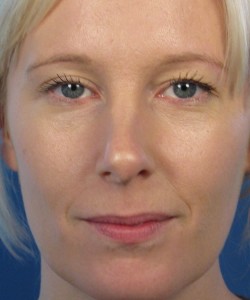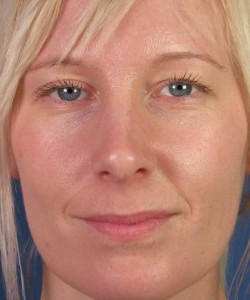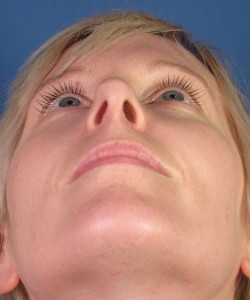One rhinoplasty topic that I see commonly discussed online is the issue of persistent nostril asymmetry following rhinoplasty. I think this is a topic that deserves some mention and clarification. Many rhinoplasty and revision rhinoplasty patients note some degree of nostril asymmetry following their nasal reshaping procedure. This is certainly more the rule than the exception. The real question is whether or not the persistent nostril asymmetry noted is easily visible on frontal view of the nose. Meaning, can people notice this when looking directly at you? Or is it just noticeable when looking from underneath the nose (called the base view)? Of course, all rhinoplasty experts and revision rhinoplasty specialists aim to achieve as much symmetry as possible. This includes creating a nose that is balanced and proportional from all views. However, the reality is that you are never going to have ‘the perfect’ nose even after a well performed rhinoplasty or revision rhinoplasty surgery. Given this fact, most rhinoplasty experts will prioritize their efforts when it comes to reshaping the nose. One of the top priorities in nasal reshaping surgery is to achieve as much symmetry and harmony as possible on frontal view since this is where most people see you. Obviously if you can correct the nostril asymmetry at the same time as achieving the desired frontal symmetry, then that would be ideal. But in some cases you simply cannot have both. There are definitely those rhinoplasty and revision rhinoplasty patients out there whose anatomy just doesn’t allow you to have perfectly symmetric nostrils as seen from below, unless you sacrifice symmetry of the nose on frontal view. What I tell many of my own San Diego rhinoplasty and San Diego revision rhinoplasty patients is that our main goal is to create as much symmetry as possible on the frontal view. If we achieve symmetry of the nostrils on base view that is great. But the priority is definitely the frontal view.
Case Example of Rhinoplasty Nostril Evaluation
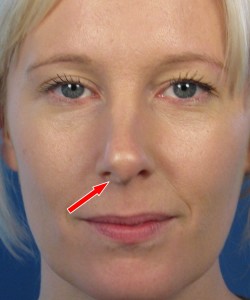
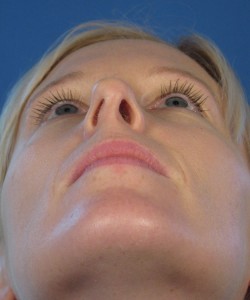 Attached is a quick case example of rhinoplasty surgery as it relates to nostril asymmetry. This particular rhinoplasty patient presented with asymmetry of her nose including the nostrils as seen on frontal view. As you can see from her before rhinoplasty photo diagram (red arrow), her right nostril was much more narrow due to a segment of cartilage that was protruding into the nostril opening. This not only created asymmetry of her nostrils on base view, but also impacted her frontal view. I performed a closed rhinoplasty procedure on her to create more symmetry (as well as to improve her nasal breathing). My priority was to create a nose that looked more symmetric on frontal view. Although I definitely attempted to create nostril symmetry at the same time, I was not going to sacrifice her frontal appearance just for the sake of gaining more equivalent sized nostril openings. As you can see from her before and after rhinoplasty photos noted below, she has a nice overall improvement in her frontal view. Her bridge is more balanced and her nostrils and nasal base look more even now. I was able to remove the excess protruding cartilage without compromising her tip support. Overall, her frontal appearance looks quite symmetric. On base view, you can also see an improvement with better symmetry related to her nostril size and shape. I am the first to admit that she still has some degree of nostril asymmetry. However, in this particular rhinoplasty patient I would not have achieved as much symmetry in her frontal appearance had I attempted to do more work on nostrils as seen from below. It came down to a matter of priorities and being realistic when it comes to rhinoplasty results. I hope this helps in clarifying some of the debate and discussion ongoing out there in the rhinoplasty world regarding persistent asymmetry of the nostrils following nasal reshaping procedures.
Attached is a quick case example of rhinoplasty surgery as it relates to nostril asymmetry. This particular rhinoplasty patient presented with asymmetry of her nose including the nostrils as seen on frontal view. As you can see from her before rhinoplasty photo diagram (red arrow), her right nostril was much more narrow due to a segment of cartilage that was protruding into the nostril opening. This not only created asymmetry of her nostrils on base view, but also impacted her frontal view. I performed a closed rhinoplasty procedure on her to create more symmetry (as well as to improve her nasal breathing). My priority was to create a nose that looked more symmetric on frontal view. Although I definitely attempted to create nostril symmetry at the same time, I was not going to sacrifice her frontal appearance just for the sake of gaining more equivalent sized nostril openings. As you can see from her before and after rhinoplasty photos noted below, she has a nice overall improvement in her frontal view. Her bridge is more balanced and her nostrils and nasal base look more even now. I was able to remove the excess protruding cartilage without compromising her tip support. Overall, her frontal appearance looks quite symmetric. On base view, you can also see an improvement with better symmetry related to her nostril size and shape. I am the first to admit that she still has some degree of nostril asymmetry. However, in this particular rhinoplasty patient I would not have achieved as much symmetry in her frontal appearance had I attempted to do more work on nostrils as seen from below. It came down to a matter of priorities and being realistic when it comes to rhinoplasty results. I hope this helps in clarifying some of the debate and discussion ongoing out there in the rhinoplasty world regarding persistent asymmetry of the nostrils following nasal reshaping procedures.

